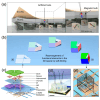Flexible Magnetic Sensors
- PMID: 37112422
- PMCID: PMC10141728
- DOI: 10.3390/s23084083
Flexible Magnetic Sensors
Erratum in
-
Correction: Pan et al. Flexible Magnetic Sensors. Sensors 2023, 23, 4083.Sensors (Basel). 2025 Apr 30;25(9):2838. doi: 10.3390/s25092838. Sensors (Basel). 2025. PMID: 40363395 Free PMC article.
Abstract
With the merits of high sensitivity, high stability, high flexibility, low cost, and simple manufacturing, flexible magnetic field sensors have potential applications in various fields such as geomagnetosensitive E-Skins, magnetoelectric compass, and non-contact interactive platforms. Based on the principles of various magnetic field sensors, this paper introduces the research progress of flexible magnetic field sensors, including the preparation, performance, related applications, etc. In addition, the prospects of flexible magnetic field sensors and their challenges are presented.
Keywords: Hall sensors; flexible electronics; flexible magnetic sensors; magnetoelectric (ME) sensors; magnetoimpedance (MI) sensors; magnetoresistance (MR) sensors; shapeable magnetoelectronics.
Conflict of interest statement
The authors declare no conflict of interest.
Figures




















Similar articles
-
Wearable Magnetic Field Sensor with Low Detection Limit and Wide Operation Range for Electronic Skin Applications.Adv Sci (Weinh). 2024 Oct;11(37):e2304525. doi: 10.1002/advs.202304525. Epub 2023 Nov 30. Adv Sci (Weinh). 2024. PMID: 38037314 Free PMC article.
-
Recent Advances in Natural Functional Biopolymers and Their Applications of Electronic Skins and Flexible Strain Sensors.Polymers (Basel). 2021 Mar 6;13(5):813. doi: 10.3390/polym13050813. Polymers (Basel). 2021. PMID: 33800960 Free PMC article. Review.
-
Recent Advances in Flexible Temperature Sensors: Materials, Mechanism, Fabrication, and Applications.Adv Sci (Weinh). 2024 Sep;11(36):e2405003. doi: 10.1002/advs.202405003. Epub 2024 Jul 29. Adv Sci (Weinh). 2024. PMID: 39073012 Free PMC article. Review.
-
Recent Advances in Flexible Sensors and Their Applications.Sensors (Basel). 2022 Jun 20;22(12):4653. doi: 10.3390/s22124653. Sensors (Basel). 2022. PMID: 35746434 Free PMC article. Review.
-
Printed magnetoresistive sensors for recyclable magnetoelectronics.J Mater Chem A Mater. 2024 Aug 15;12(37):24906-24915. doi: 10.1039/d4ta02765e. eCollection 2024 Sep 24. J Mater Chem A Mater. 2024. PMID: 39234481 Free PMC article.
Cited by
-
Correction: Pan et al. Flexible Magnetic Sensors. Sensors 2023, 23, 4083.Sensors (Basel). 2025 Apr 30;25(9):2838. doi: 10.3390/s25092838. Sensors (Basel). 2025. PMID: 40363395 Free PMC article.
-
Enhanced Digital Light Processing-Based One-Step 3-Dimensional Printing of Multifunctional Magnetic Soft Robot.Cyborg Bionic Syst. 2025 Feb 26;6:0215. doi: 10.34133/cbsystems.0215. eCollection 2025. Cyborg Bionic Syst. 2025. PMID: 40017698 Free PMC article.
-
A Positioning System Design Based on Tunnel Magnetoresistance Sensors for Rapid Zoom Optical Lens.Sensors (Basel). 2025 Mar 14;25(6):1820. doi: 10.3390/s25061820. Sensors (Basel). 2025. PMID: 40292936 Free PMC article.
-
Thermally Drawn Flexible Fiber Sensors: Principles, Materials, Structures, and Applications.Nanomicro Lett. 2025 Jul 18;18(1):4. doi: 10.1007/s40820-025-01840-y. Nanomicro Lett. 2025. PMID: 40679655 Free PMC article. Review.
References
-
- Makarov D., Melzer M., Karnaushenko D., Schmidt O.G. Shapeable magnetoelectronics. Appl. Phys. Rev. 2016;3:011101. doi: 10.1063/1.4938497. - DOI
-
- Yang H.-L., Xie Y.-L., Lu Z.-X., Wang Z.-M., Li R.-W. Research progress of flexible magnetic films and devices. Acta Phys. Sin. 2022;71:097503. doi: 10.7498/aps.71.20212354. - DOI
Publication types
Grants and funding
LinkOut - more resources
Full Text Sources

